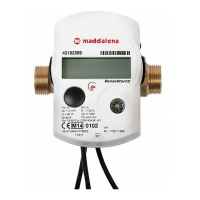Doc. code 1080100090 Version: 2015_03_03 8
Battery lifetime, estimated
Standard: 10 years; 6 years + 1 with pulse output: see
“Influencing_factors_battery_lifetime”.
8 digits + special characters
M-Bus galvanically isolated; M-Bus galvanically isolated + 2 pulse inputs;
wireless M-Bus; wireless M-Bus + 2 pulse inputs; pulse output
platinum precision resistor Pt500
9 Interfaces and Options
9.1 Optical (infrared) interface
For the communication with the optical interface an optocoupler and the ‘Device Monitor’ is necessary. The
optocoupler and the ‘Device
Monitor’ software are available as accessory equipment.
Baud rate: 2400 baud
The optical (infrared) interface is activated by pressing the push-button.
If within 60 seconds neither a valid telegram is received nor the push-button pressed again, the interface is
deactivated. The number of read-outs via the optical interface is limited to 300 times per day.
9.2 M-Bus (optional)
The M-Bus is a galvanically isolated interface for the transmission of meter data (absolute values).
9.3 General information about the M-Bus interface
It is important to note that the acknowledged state of the art technology rules and the relevant legal restraints
(international and local; see 9.3.1 “Relevant norms, standards and literature”) are to be observed.
The installation has to be performed by authorized, skilled persons.
If the regulations and the information in the installation and operating instruction manuals are not strictly
followed, or if the installation is shown to be faulty, any resulting expenses will be charged to the company
responsible for the installation.
Recommended type of cable: telephone cable J-Y(ST)Y 2x2x0.8mm².
It is important to make sure that the topology of the M-Bus network (cable lengths and cross-sections) is suitable
for the baud rate (2400 Bd) of the end instruments.
Further information can be found in the detailed ‘Application Note M-Bus’ at www.engelmann.de.
9.3.1 Relevant norms, standards and literature on the M-Bus
Low-voltage electrical installations - Part 4-41: Protection for safety -
Protection against electric shock
Low-voltage electrical installations - Part 4-44: Protection for safety -
Protection against voltage disturbances and electromagnetic
disturbances
Electrical installations of buildings - Part 5-51: Selection and erection of
electrical equipment - Common rules
Low-voltage electrical installations - Part 5-54: Selection and erection of
electrical equipment - Earthing arrangements and protective conductors
Application of equipotential bonding and earthing in buildings with
information technology equipment

